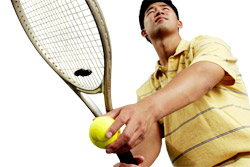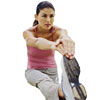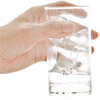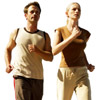- What are exercise-associated muscle cramps?
- When exercise-associated muscle cramps occur
- What causes exercise-associated muscle cramps?
- Clinical features of exercise-associated muscle cramps
- Distinguishing between types of exercise-associated muscle cramps
- How to prevent exercise-associated muscle cramps
- How to treat exercise-associated muscle cramps
What are muscle cramps?
Muscle cramps are painful, sometimes disabling, involuntary contractions of a muscle normally under voluntary control (skeletal muscle). They are caused by abnormal functioning of the motor nerves which control muscles. Cramps are exacerbated when the nervous system is stressed.
 |
For more information, see Muscle Cramps. |
Muscle cramps can also be associated with intense exercise. An exercise-associated muscle cramp (EAMC) is a painful, involuntary contraction of skeletal muscle which occurs immediately after or during exercise.
EAMCs are commonly experienced by athletes and are one of the most common conditions that require medical attention during or after sporting events. The incidence of EAMCs increases with higher frequency, intensity and duration of the exercise, and are especially prevalent in endurance athletes such as marathon runners.
When exercise-associated muscle cramps occur

- Triathlons; and
- Marathon running.
EAMCs are also common in many sports, including:
- Football;
- Basketball;
- Rugby;
- Tennis;
- Cricket; and
- Cycling.
EAMCs are seen more commonly in competitive environments were the racing pace is faster than the training pace. Exercising in hot and humid environments is also known to increase the risk of experiencing EAMCs.
What causes exercise-associated muscle cramps?
The cause of EAMCs is not entirely understood, but it is believed to be due to:
- Muscle fatigue;
- Dehydration and electrolyte loss; or
- A combination of both.
Muscle cramping as a result of muscle fatigue is thought to be due to the nervous system having a loss of control over the muscles (neuromuscular control) due to the excessive physical stress placed on muscles during sporting events.
Muscle cramping due to dehydration is mainly achieved through sweating. The more people sweat, the more sodium (salt) they will lose. Sodium is an electrolyte that is important for hydration. The degree of electrolyte loss will depend on the sweating rate, concentration of sodium in sweat, and the dietary intake of the athlete. Regardless of individual differences, after exercising continuously for around 3–4 hours, the sodium concentration in sweat will generally be high in most people.
There is quite a bit of overlap between cramps that occur due to muscle fatigue and cramps due to dehydration; it follows that if an individual is losing excessive sweat due to exercise, they are more than likely fatiguing their muscles. There are, however, distinguishing features between the two.
Clinical features of exercise-associated muscle cramps

If the exercise is continued once a cramp has developed, it will commonly be followed by muscle twitching and spasmodic spontaneous contractions of the muscle. These muscle twitches or fasciculation will be visible in the affected muscle.
People who have poor stretching habits, a history of cramping, have undergone extreme exercise, or are of older age are at risk for developing EAMCs.
Distinguishing between types of exercise-associated muscle cramps
EAMCs that are due to muscle overload and fatigue are likely to display the following characteristics:
- Comparatively sudden onset, seemingly related to fatigue and exertion rather than dehydration;
- Localised to one muscle;
- Constant muscle contractions;
- Asymmetric muscle contraction (e.g. only one calf muscle will be affected); and
- Is slightly relieved after passive stretching and/or massage.
EAMCs that are due to electrolyte depletion and dehydration are likely to display the following characteristics:
- Fasciculation or slight cramping that develop over a longer period of time;
- Progression of cramp severity from relatively mild to more severe and widespread;
- Bilateral (e.g. both calf muscles may be affected);
- Intermittent muscle spasms; and
- Profuse sweating and other signs of dehydration.
If your doctor determines that the muscle cramp does not show obvious signs of being exercise-associated, they may perform a special investigation to rule out an underlying medical cause. Specific signs that indicate the muscle cramp is not exercise-associated include:
- Contraction of muscles that have not been exercised in the activity preceding the cramp;
- Severe cramping in a number of muscles (generalised cramping);
- Concurrent confusion; and
- The athlete is in a semicoma or coma.
If you experience recurrent episodes of EAMCs you may have an underlying medical condition. In this case, a full medical history and examination will be performed.
If your doctor suspects that the muscle cramp is not an EAMC, they will refer you to a specialist or, in severe cases, you will be taken to the emergency department.
How to prevent exercise-associated muscle cramps

Athletes who are prone to cramping as a result of dehydration and electrolyte depletion will develop a sodium deficit if their sweat losses after exercise are not immediately subsidised by diet. At the first sign of muscle twitching, your doctor may suggest a generous intake (half a litre) of a high-salt solution drink to prevent the cramp from developing. Salt tablets can also be an effective preventative strategy if they are consumed with plenty of water.
For those who tend to experience cramps due to muscle fatigue, preventive measures can include:
- Reducing training and competition intensity and duration;
- Improving conditioning (preparation) and range of motion of muscles;
- Adjustments to equipment configuration and selection (this may be altering the height of the bicycle seat and handle position, or a change of shoes);
- Consuming the appropriate amounts of carbohydrate before training or competition to reduce the likelihood of fatigue;
- Your doctor might look at how your muscles are working and structured (the muscle biomechanics) and suggest exercises that can strengthen or stretches that will improve flexibility; and
- Using relaxation techniques before an event, such as massage and stretching.
How to treat exercise-associated muscle cramps
Without completely understanding what causes EAMCs, treatment options are limited, but there are some immediate actions that can be taken to reduce the severity of the cramp and relieve the pain. The first step in treating any EAMC is to stop the exercise that is causing the cramping.
If the cramp is due to muscle overload and fatigue, treatment options for the affected muscle may include:
- Massage;
- Passive stretching;
- Lowering or altering the muscle load; and/or
- Icing.
For any athlete, it is important to replace the water and electrolytes that were lost during the exercise. Ingesting salt will help ingested fluids be sufficiently restored and retained.
More information
 |
For more information on stretching, see Exercise Stretches. |
 |
For more information on rehydrating, see Exercise Recovery: Rehydration After Exercise. |
 |
For more information on fitness and exercise, including stretches, types of exercise, exercise recovery and exercise with health conditions, as well as some useful videos, see Fitness and Exercise. |
References
- Katzberg HD, Khan AH, So YT. Assessment: Symptomatic treatment for muscle cramps (an evidence-based review): Report of the therapeutics and technology assessment subcommittee of the American Academy of Neurology. Neurology. 2010;74(8):691-6. [Abstract | Full text]
- Schwellnus MP, Drew N, Collins M. Muscle cramping in athletes: Risk factors, clinical assessment, and management. Clin Sport Med. 2008;27(1):183-94. [Abstract]
- Schwellnus MP. Cause of exercise associated muscle cramps (EAMC): Altered neuromuscular control, dehydration or electrolyte depletion? Br J Sport Med. 2009;43(6):401-8. [Abstract]
- Bergeron M. Muscle cramps during exercise: Is it fatigue or electrolyte deficit? Curr Sports Med. 2008;7(4 Suppl):S50-5. [Full text]
- Muscle cramp [online]. Rosemont, IL: American Academy of Orthopaedic Surgeons; May 2010 [cited 7 November 2010]. Available from: [URL link]
All content and media on the HealthEngine Blog is created and published online for informational purposes only. It is not intended to be a substitute for professional medical advice and should not be relied on as health or personal advice. Always seek the guidance of your doctor or other qualified health professional with any questions you may have regarding your health or a medical condition. Never disregard the advice of a medical professional, or delay in seeking it because of something you have read on this Website. If you think you may have a medical emergency, call your doctor, go to the nearest hospital emergency department, or call the emergency services immediately.







